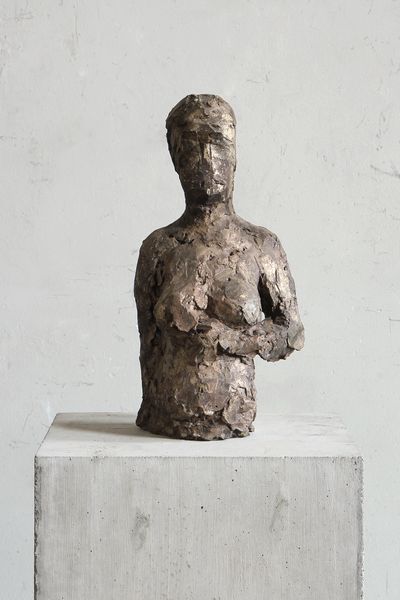Josephsohn reviewed by ARTFORUM

Hans Josephsohn, ‘Untitled ‘, 2002 © Josephsohn Estate. Courtesy Josephsohn Estate and Kesselhaus Josephsohn
Josephsohn reviewed by ARTFORUM
30 January 2018
'Looking at Josephsohn's sculptures offer the viewer a pleasure of a peculiarly aesthetic kind.'
On the wall, what appeared to be a section of a heavily weathered archaic frieze. Before it, four monolithic gray forms, reverentially displayed on plinths: Anamorphs, they at first faintly recall Chinese philosopher's stones or Easter Island heads wind-blasted beyond recognition. They appear formed from an ur-material that recalls iron, stone, and butter all at once. Over rime, the viewer is able to discern identifiably human features, and the works on the plinths arc revealed to be unmistakably human busts, with expressions ranging from the mournful to the puckish.
The atmosphere these works bestow is both majestic-the display of the matter is sacramental and the scale is imposing-and inescapably humorous. Looking at Josephsohn's sculptures offer the viewer a pleasure of a peculiarly aesthetic kind. When Hans Belting encountered Josephsohn's work in Massimiliano Gioni's 2'013 Venice Biennale, he expressed pleasurable shock at not knowing whether they were of ancient or modern manufacture. And it's true, it is hard to know from what era they comeor what they arc made of, how they are made, or whether if they are abstract or figurative, somber or funny. It is difficult even to know how far away to stand from these busts; the stately curves push the viewer back, while the rough texture and variegated pattern of the cast tempts her forward.
The double movement confuses the perception of scale, and in the absence of other. visitors in the gallery, a hallucinatory uncertainty about spatial relations secs in. The Swiss writer Paul Nizon mentioned experiencing the same disorientation while visiting Josephsohn's studio in 1971, when the sculptor would at times seem to vanish amid a plaster forest of his own works.

Hans Josephsohn, ‘Untitled’, 1969 © Josephsohn Estate. Courtesy Josephsohn Estate and Kesselhaus Josephsohn
The conflict between formality and humor might be what attracted Fischli & Weiss to the works. They, along with a generation of Swiss artists and architects, adopted Josephsohn as a kind of patron saint. His influence is palpable, and not only on the antiheroics of Fischli & Weiss's series "Plötzlich diese Obersicht" (Suddenly This Overview), 1981-. Josephsohn taught Ugo Rondinone about the power latent in an artwork's passivity, and the architect Peter Märkli claims. Josephsohn instructed him on how to use his eyes.
Widespread recognition came late; for much of his life, this refugee-who was born in what was then Königsberg, East Prussia, and had to flee his newly adopted home city of Florence when Italy introduced anti-Semitic legislation in 1938-was benignly ignored. Jürg Hassler's 1977 film Stein des Anstosses (Stumbling Block) captures the manual nature of Josephsohn's labor as the artist constructed his monumental busts out of plaster. Motivated by Hassler's film, Felix Lehner visited Josephsohn in the early 1980s.
The relationship between the young student and the much older artist would prove pivotal for both. Lehner would go on to found the Sitterwcrk, the specialist foundry that is now internationally famous for its artisanal casts, in order to fulfill Josephsohn's desire to see his most loved works in bronze. Turning up at his studio every day for decades, in his plaster-spattered clothes, Josephsohn would work and sit and work, as stubbornly oblivious to the movements that waxed and waned around him as were Alberto Giacometti or Giorgio Morandi, with whom he is often compared.
Working whenever possible in the presence of a live model, he would accrete material, only to carve it away again, sometimes with his hare hands, sometimes with an ax. The process, unfolding according to unwavering hut inscrutable criteria, was sometimes delicate, sometimes ballistic. Josephsohn was an outsider artist in the sense that Paul Chan uses the term-someone who believes too sincerely in the redemptive mission of art to function as a professional.
Related News
1 / 5




